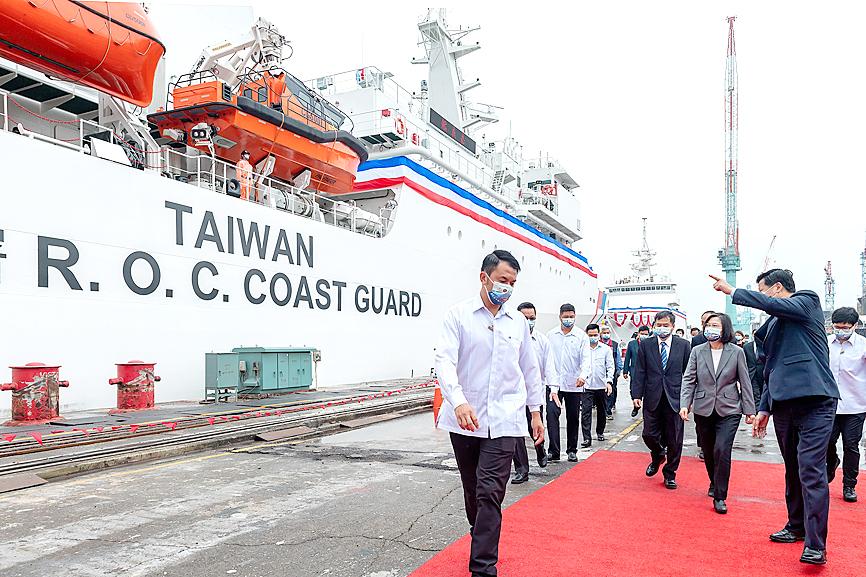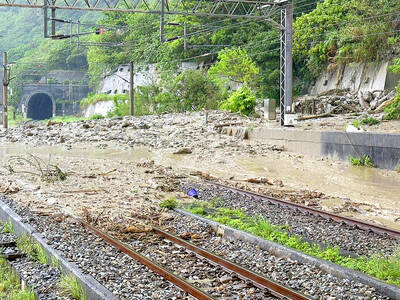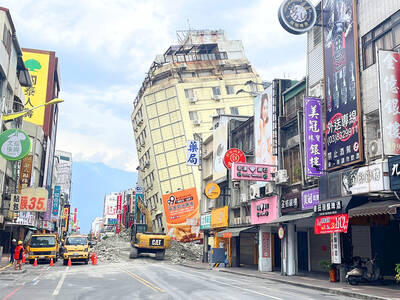President Tsai Ing-wen (蔡英文) yesterday presided over a ceremony in Keelung to inaugurate a 4,000-tonne-class coast guard ship, named the Chiayi (嘉義), while highlighting the coast guard’s cooperation with the US.
Tsai toured the Chiayi at CSBC Corp, Taiwan’s (台船) shipyard and attended the christening of its sister vessel, the Hsinchu (新竹), both commissioned by the Coast Guard Administration (CGA).
Tsai said that the delivery of the Chiayi and the production of sister ships bolsters the coast guard’s capabilities and offers greater protection for CGA staff.

Photo courtesy of the Presidential Office
The Chiayi and the launch of the navy’s Yu Shan (玉山) amphibious transport dock two weeks ago in Kaohsiung are proof that the government’s indigenous shipbuilding projects and increased national defense autonomy is on track, Tsai said.
Last month, Taiwan and the US signed a memorandum of understanding for the nations’ coast guards to collaborate in preserving maritime resources; reducing illegal, unreported and unregulated fishing; and allowing for joint maritime search-and-rescue missions, as well as environmental response events, she said.
Although a 4,000-tonne-class vessel, the Chiayi has almost 5,044 tonnes of displacement, and could sail for 10,000 nautical miles (18,520km) before needing to refuel, CSBC president Cheng Wen-lon (鄭文隆) said.
Designed as a mobile seaborne field hospital, the ship is outfitted with a negative-pressure isolation ward, an operating room and other facilities that would enable it to perform humanitarian relief and search-and-rescue missions, Cheng said.
The ship also has a landing pad for rotary-wing aircraft, he added.
Su Tzu-yun (蘇紫雲), a research fellow at the Institute for National Defense and Security Research, said that the ship could also be retrofitted for combat.
Based on the design of the US Coast Guard’s Legend-class National Security Cutter, the Chiayi follows the “blue-water navy” concept, meaning that it is capable of operating globally, Su said.
The vessel is close to the size of a navy ship and is equipped with 70mm rockets, 20mm cannons, a water cannon with a range of 120m and an air pad capable of launching uncrewed aerial vehicles, Su said, adding that in a conflict, it could be used against landing craft or enemy naval vessels.
The US and Japan have laws that allow coast guard ships to be retrofitted for combat, Su said.
The CGA said it remains in negotiations with CBSC to head efforts to construct ships, and handle maintenance and repairs.
Additional reporting by CNA

ROLLER-COASTER RIDE: More than five earthquakes ranging from magnitude 4.4 to 5.5 on the Richter scale shook eastern Taiwan in rapid succession yesterday afternoon Back-to-back weather fronts are forecast to hit Taiwan this week, resulting in rain across the nation in the coming days, the Central Weather Administration said yesterday, as it also warned residents in mountainous regions to be wary of landslides and rockfalls. As the first front approached, sporadic rainfall began in central and northern parts of Taiwan yesterday, the agency said, adding that rain is forecast to intensify in those regions today, while brief showers would also affect other parts of the nation. A second weather system is forecast to arrive on Thursday, bringing additional rain to the whole nation until Sunday, it

LANDSLIDES POSSIBLE: The agency advised the public to avoid visiting mountainous regions due to more expected aftershocks and rainfall from a series of weather fronts A series of earthquakes over the past few days were likely aftershocks of the April 3 earthquake in Hualien County, with further aftershocks to be expected for up to a year, the Central Weather Administration (CWA) said yesterday. Based on the nation’s experience after the quake on Sept. 21, 1999, more aftershocks are possible over the next six months to a year, the agency said. A total of 103 earthquakes of magnitude 4 on the local magnitude scale or higher hit Hualien County from 5:08pm on Monday to 10:27am yesterday, with 27 of them exceeding magnitude 5. They included two, of magnitude

CONDITIONAL: The PRC imposes secret requirements that the funding it provides cannot be spent in states with diplomatic relations with Taiwan, Emma Reilly said China has been bribing UN officials to obtain “special benefits” and to block funding from countries that have diplomatic ties with Taiwan, a former UN employee told the British House of Commons on Tuesday. At a House of Commons Foreign Affairs Committee hearing into “international relations within the multilateral system,” former Office of the UN High Commissioner for Human Rights (OHCHR) employee Emma Reilly said in a written statement that “Beijing paid bribes to the two successive Presidents of the [UN] General Assembly” during the two-year negotiation of the Sustainable Development Goals. Another way China exercises influence within the UN Secretariat is

Taiwan’s first drag queen to compete on the internationally acclaimed RuPaul’s Drag Race, Nymphia Wind (妮妃雅), was on Friday crowned the “Next Drag Superstar.” Dressed in a sparkling banana dress, Nymphia Wind swept onto the stage for the final, and stole the show. “Taiwan this is for you,” she said right after show host RuPaul announced her as the winner. “To those who feel like they don’t belong, just remember to live fearlessly and to live their truth,” she said on stage. One of the frontrunners for the past 15 episodes, the 28-year-old breezed through to the final after weeks of showcasing her unique